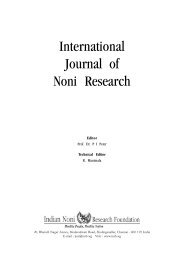International Journal of Noni Research - Noni Family
International Journal of Noni Research - Noni Family
International Journal of Noni Research - Noni Family
You also want an ePaper? Increase the reach of your titles
YUMPU automatically turns print PDFs into web optimized ePapers that Google loves.
P. Rethinam et al. <strong>Noni</strong> (Morinda citrifolia L.) - the Miracle Fruit - a holistic review<br />
leaf curling, purpling and marginal necrosis are some <strong>of</strong> the distinct deficiency<br />
symptoms.<br />
Harvest and Post Harvest Processing<br />
Harvesting Stage<br />
Depending on the post-harvest technology programme adopted, the fruits may<br />
be harvested at different stages <strong>of</strong> development. After harvesting <strong>Noni</strong> ,the<br />
fruit ripens within a week at ambient temperature and also because <strong>of</strong> its<br />
short storage life the fruits cannot be transported to the distant places even<br />
with in the country. To over come the problem harvesting fruits with pedicel<br />
helped to maintain better quality and market acceptability and highest spoilage<br />
<strong>of</strong> fruits was observed in fruits harvested without pedicel (Fruits with pedicel<br />
performed well in terms <strong>of</strong> keeping quality, ascorbic acid and TSS. Among the<br />
accessions, SPG-2 recorded minimum loss <strong>of</strong> weight (2.90%) followed by<br />
Pbay-7 (3.74 %) in 9 days during storage (Singh et al.2007). The evolution<br />
<strong>of</strong> the colour and firmness <strong>of</strong> fruits left to ripen naturally on the tree is<br />
reported in Table 1. Nonetheless, most processors buy <strong>Noni</strong> harvested at the<br />
''hard white'' stage for juice production, as the fruits become s<strong>of</strong>t too quickly<br />
once this stage P. Rethinam et al. <strong>Noni</strong> (Morinda citrifolia L.) - the Miracle Fruit<br />
- a holistic review 8 Intl. J. <strong>Noni</strong> Res. 2007, 2(1-2) is reached (Nelson, 2001,<br />
2003). The change from stage 4 to stage 5 occurs very quickly (few hours) and<br />
the pulp practically liquefies and turns from green to white, as well as develops<br />
the characteristic butyric smell. The fruits are individually selected on the tree and<br />
harvested by hand. At the ''hard white'' stage, they are well able to withstand being<br />
transported in baskets or containers, and exposure <strong>of</strong> the fruits to light or high<br />
temperatures immediately after harvest does not affect their overall quality. Before<br />
processing, fruits are ripened at room temperature for a day or more, depending<br />
on the end product (tea, juice, pulp, dietetic products, etc. (Nelson, 2003).<br />
Table 1. Evolution <strong>of</strong> fruit skin colour and firmness in the course<br />
<strong>of</strong> ripening.<br />
Maturity stage Colour Firmness<br />
1. Dark green Very hard<br />
2. Green-yellow Very hard<br />
3. Pale yellow Very hard<br />
4. Pale yellow Fairly hard<br />
5. Translucent-grayish S<strong>of</strong>t<br />
Intl. J. <strong>Noni</strong> Res. 2007, 2(1-2) 12








